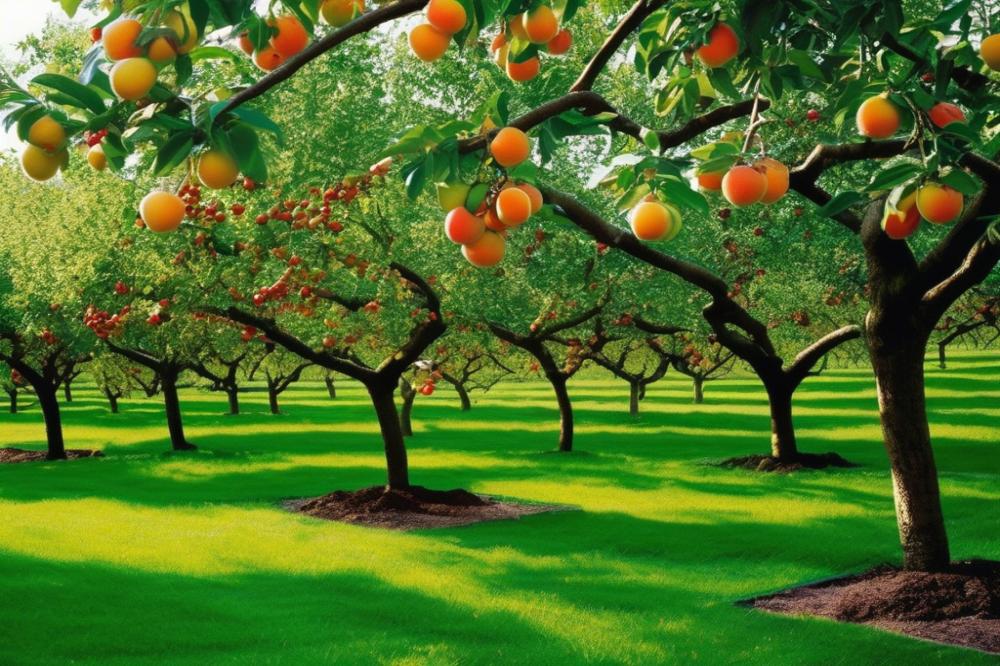Introduction
fertilizing fruit trees is essential for achieving healthy growth and a bountiful harvest. Many gardeners dream of lush, fruit-laden branches swaying gently in the breeze. To reach this goal, understanding the needs of these trees is vital. Healthy trees depend on proper nourishment and care. Gardeners must consider how to meet these needs through thoughtful practices.
Healthy fruit trees require a balance of nutrients, which contribute to their overall well-being. The key elements include nitrogen, phosphorus, and potassium, often referred to as N-P-K. Maintaining optimal soil health can make a significant difference in fruit production. Soil quality impacts the root system, allowing trees to absorb water and nutrients effectively. Gardeners should regularly check soil pH levels to ensure they remain within a suitable range for their trees.
The use of organic fertilizers plays a crucial role in nurturing these trees. Compost, for example, enriches the soil with essential nutrients while boosting microbial activity. This not only helps in nutrient availability but also improves moisture retention. Different application methods can be employed, such as sprinkling fertilizers around the base or integrating them into the soil during the pruning season. Timing is another important factor, as applying nutrients at the right moments can significantly affect tree health.
A well-crafted fertilization schedule is necessary for optimal growth and fruit production. Seasonal timing aligns the nutrients with the natural growth cycles of the trees. Gardeners should also remember that proper fruit tree care extends beyond just fertilization. Regular pruning can enhance air circulation and sunlight exposure, contributing to overall vitality. Healthy, nourished trees will reward their caretakers with a plentiful harvest, making the effort worthwhile.
Understanding the Nutritional Needs of Fruit Trees


Fruit trees require a mix of essential nutrients to grow healthy and produce a bountiful harvest. Key nutrients include nitrogen, phosphorus, and potassium, often referred to as N-P-K. These three play critical roles in plant growth. Additionally, trace elements like iron, zinc, and manganese contribute significantly to healthy development.
Nitrogen is vital for foliage growth and photosynthesis. It helps trees develop lush green leaves, which are important for absorbing sunlight. Phosphorus supports root development and flowering, while potassium enhances fruit quality and helps the tree withstand stress. Each of these nutrients must be present in the right balance to support the overall health of the tree.
Signs of Nutrient Deficiencies in Fruit Trees
Identifying nutrient deficiencies can be straightforward if you know what to look for. A tree that lacks nitrogen might exhibit yellowing leaves and reduced leaf growth. When phosphorus is deficient, trees may struggle with root development, and the leaves could turn dark green or purple. On the other hand, potassium deficiency can lead to poor fruit quality and marginal leaf burn.
Look closely at your tree. If you notice stunted growth or weak fruit production, there may be nutrient issues at play. Pruning can sometimes help trees recover by improving air circulation and light penetration. However, it’s crucial to first understand what nutrients your tree might be lacking.
Role of pH Levels in Nutrient Availability
The pH level of the soil directly influences how well trees can absorb nutrients. Most fruit trees thrive in slightly acidic to neutral soil, with pH levels ranging from 6.0 to 7.0. Outside of this range, certain nutrients become less available. For instance, at too high a pH, iron becomes difficult for trees to take up, leading to chlorosis, which appears as yellowing leaves.
Maintaining good soil health is essential for nutrient absorption. Organic fertilizers, such as compost, can help regulate pH and provide necessary nutrients naturally. Developing a proper fertilization schedule is important, as seasonal timing can impact nutrient availability and absorption. Regular testing of soil pH is recommended to keep your fruit trees flourishing.
The Role of Soil Health in fertilizing fruit trees


Healthy soil is critical for the development of a strong root system. Roots need space to grow and search for water and nutrients. When the soil is compacted or lacks structure, the roots struggle to spread out. This can lead to stunted growth and poor fruit production. Ensuring that the soil has a good texture is essential.
Soil health greatly influences how well plants absorb nutrients. Microorganisms within the soil break down organic matter, which makes nutrients accessible to the roots. This natural process supports the tree as it grows. On the other hand, soil that lacks these beneficial microbes can lead to nutrient deficiencies, impacting the overall health of the tree. Balancing pH levels is another important aspect, as it affects nutrient availability in the soil.
Compost acts as an excellent amendment to improve soil health and fertility. Adding compost not only enriches the soil with organic matter, but it also enhances water retention. This is especially helpful during dry spells. Regular application of compost can create a thriving environment for microorganisms, further supporting nutrient absorption. A well-planned fertilization schedule will take advantage of these benefits.
Different application methods can be used for adding compost or organic fertilizers. Some gardeners prefer top-dressing the soil, while others may choose to incorporate it into the soil directly. Each method has its advantages, depending on the tree’s needs and the specific growing conditions. Seasonal timing also plays a role. Applying compost in the spring can provide essential nutrients as trees begin to grow. Regular pruning helps manage the foliage, allowing the tree to focus more energy on producing fruit.
Choosing the Right Fertilizers


Gardeners face a crucial decision when it comes to selecting fertilizers for fruit trees. Some may opt for organic fertilizers, while others prefer synthetic options. Each type has its advantages and disadvantages and understanding these can help improve your garden’s yield.
Organic fertilizers often come from natural sources such as compost or manure. These products release nutrients slowly, feeding the plants over time. By using these, gardeners can also enhance soil health. Healthy soil supports a robust root system, which belongs to the trees. In addition, organic options usually have a lower environmental impact. They promote biodiversity in the soil and help maintain balanced pH levels.
Synthetic fertilizers, on the other hand, tend to deliver nutrients quickly. These might seem beneficial for instant results, yet they can harm soil health in the long run. Excessive use of synthetic products can lead to nutrient imbalances. This can affect not only plants but also nearby ecosystems. Therefore, it’s important to weigh short-term gains against potential long-lasting effects.
Benefits of Organic Fertilizers for Long-term Soil Health
Organic fertilizers can significantly improve soil structure. This enhances water retention and aeration, crucial for healthy growth. Microorganisms thrive in organic-rich soil, aiding nutrient cycling. Over time, this builds resilience against diseases and pests. Such a living soil ecosystem is vital for the longevity of fruit trees.
Consider materials like worm castings or fish emulsion. These unique fertilizers contain essential nutrients such as nitrogen, phosphorus, and potassium. Spreading a thin layer of compost around the base of trees can provide a slow-release source of nutrients. This simple act nurtures the trees while also enriching the soil. Also, using organic products can help prevent nutrient runoff, promoting sustainability.
Recommendations for Specific Types of Fertilizers for Fruit Trees
Choosing the correct fertilizer requires understanding the needs of your specific fruit trees. During the growing season, many trees benefit from balanced fertilizers like 10-10-10 or 5-10-10 blends. These indicators show the ratio of nitrogen, phosphorus, and potassium. Spring is an ideal time for the first application, as trees begin leafing out. A second application might occur in early summer to support ongoing growth.
For trees in sandy soils, consider using fertilizers that contain a higher level of potassium. Potassium helps enhance fruit quality and increases the tree’s overall disease resistance. When it comes to nutrient deficiencies, soil testing can provide vital information. Knowing specific nutrient needs can help tailor a fertilization schedule for optimal results.
A good practice is to combine fertilization with regular pruning. This encourages healthier growth and better air circulation around the branches. Pruning not only helps the trees manage their nutrient needs but also improves fruit production. It’s essential to align fertilization with seasonal timing, ensuring trees receive nutrients when they need them most.
Application Methods for Effective Fertilization


Gardening is an art that requires knowledge of proper care techniques. Among these, understanding application methods plays a crucial role in fertilizing fruit trees. There are several methods to effectively deliver nutrients to your trees. Common approaches include broadcasting, banding, and foliar feeding. Each method has its advantages and may suit different circumstances.
Overview of Various Application Methods
Broadcasting involves spreading fertilizer evenly over the entire area. This method is straightforward and suitable for larger spaces. However, it may not target the root system directly. Banding, in contrast, places fertilizers in bands close to the plant. This retains nutrients near the roots and can improve absorption. On the other hand, foliar feeding supplies nutrients directly to the leaves. This method can provide quick access to certain nutrients, but it may not be effective for all trees.
Factors to Consider for Choosing the Right Method
When selecting a method, seasonal timing is essential. Trees typically need different nutrients at various times of the year. Understanding soil health and pH levels can guide your choices too. If the soil does not retain nutrients well, banding may be preferable. Furthermore, consider the type of fertilizer. Organic fertilizers may have different application requirements than synthetic options. Choose a method that aligns with your gardening goals and the needs of your trees.
Tips to Avoid Fertilizer Runoff and Protect the Environment
Minimizing fertilizer runoff is vital for maintaining a healthy garden ecosystem. One effective way to do this is to apply fertilizers during dry weather. Wet conditions can cause nutrients to wash away. Also, incorporating compost into the soil improves its health and nutrient-retaining capabilities. Establishing a fertilization schedule helps ensure that you only apply what your trees need. Regular pruning can also improve nutrient absorption and reduce waste. Always read the instructions on your fertilizer to prevent over-application.
Pruning and Its Relationship to Fertilizing
Pruning plays a crucial role in the health and growth of fruit trees. It impacts the nutrient demand of trees, which in turn relates to their fertilization needs. When you prune, you often remove old or crowded branches. This action shifts how much energy the tree uses and how it takes up nutrients.
The timing of pruning is important. Seasonal timing should align with a fertilization schedule for effective growth. Early spring is often ideal for many fruit trees. At this time, the tree is waking up and can benefit greatly from added nutrients.
Best Practices for Coordinating Fertilization and Maintenance
Coordinating pruning and fertilization is key for optimal growth. Applying organic fertilizers just after pruning can provide immediate support. Consider the tree’s root system when you choose your application methods. Deep roots may require different strategies than shallow ones.
Monitoring soil health is necessary. The right pH levels can affect how well the tree absorbs nutrients. Regularly applying compost can help maintain proper conditions. This practice enriches the soil and ensures a balanced supply of nutrients.
Fruiting trees, like apples and peaches, may benefit from different pruning styles. Each variety has its own unique nutrient demands. Understanding these details allows for better planning. Keeping a close eye on tree health can help in deciding when and how to prune.
Ultimately, the goal is a vibrant and productive tree. Knowledge of pruning and fertilization interdependence can lead to better care. A well-timed fertilization approach will support your tree’s growth throughout the seasons. Regular assessments of your tree’s condition will guide your maintenance decisions.
Timing and Frequency of Fertilization
Understanding the seasonal timing for fertilization is essential for the health of fruit trees. Spring is typically the most crucial time. As trees wake from dormancy, they need nutrients to support new growth. Soils warm up, allowing roots to absorb essential elements. Consider testing soil pH levels before applying any fertilizers. This will help determine what nutrients the soil lacks.
Developing a fertilization schedule based on tree age and type is another vital aspect. Young trees usually require different nutrients compared to mature ones. Newer trees benefit from higher nitrogen levels to encourage strong vegetative growth. On the other hand, established trees need a balanced nutrient mix for fruit production. As trees mature, adjusting their nutrient intake can improve overall yield.
Adjusting fertilization frequency according to growth stages is important. In the early spring, applying organic fertilizers can stimulate growth. For young fruit trees, fertilization may occur every four to six weeks. As trees grow, this can change to just a couple of times during the growing season. Monitoring the tree’s development is key. Signs of nutrient deficiency or excess can help fine-tune the schedule.
During the summer, frequent watering helps maintain soil health. If the soil dries out, the tree struggles to absorb nutrients. In late summer, a careful application of compost can prepare trees for dormancy. This method not only nourishes the roots but also enhances soil structure. The right balance of nutrients supports a healthy root system in the long term.
Those involved in pruning should time their fertilization accordingly. After pruning, trees can benefit from additional nutrients, as they focus on healing and growth. This timing allows trees to recover faster and can lead to more fruitful harvests. Observing how trees respond to fertilization will lead to better practices each growing season.
Key Takeaways and Final Thoughts
Plant care requires careful consideration regarding many factors. Fertilizing fruit trees is a crucial aspect of promoting healthy growth and abundant harvests. Understanding the specific needs of your trees will guide you in choosing the right products. Soil health plays a significant role in this process. A nutrient-rich environment helps plants thrive, leading to better fruit quality.
Remember to prioritize the type of fertilizer you apply. Different trees have various nutrient requirements at different growth stages. Regular testing of your soil can provide insights into its nutrient levels. This practice informs your fertilizing schedule and amounts, ensuring balanced growth. Each tree may show distinct signs of nutrient deficiency, so being observant is essential.
Healthy fruit trees are a blend of the right nutrition and overall care. It’s not just about adding fertilizer. Watering, pruning, and pest management are equally important. By addressing all aspects of tree care, you’ll create a thriving ecosystem around your plants. Never forget that neglecting one area can affect the others.
In essence, pursuing soil health alongside appropriate nutrient management will lead to fruitful outcomes. Engage with your garden regularly and adapt your strategies as necessary. Observing how your trees respond to different treatments will enhance your ability to nurture them. Striking the right balance will ultimately reward your efforts with delicious fruits for many seasons to come.



